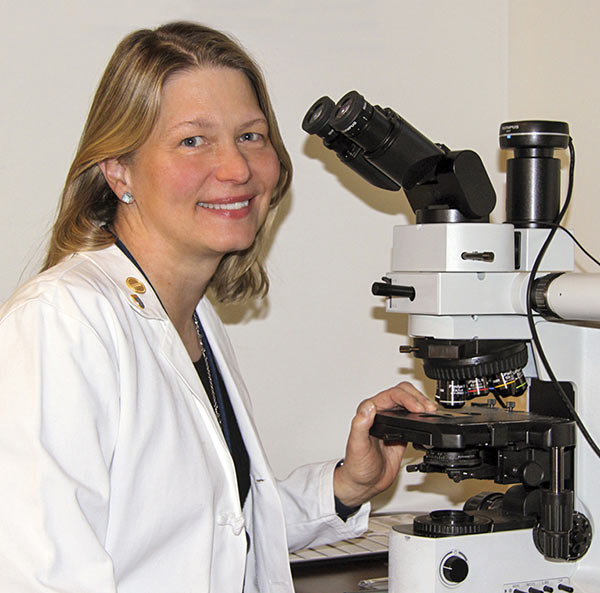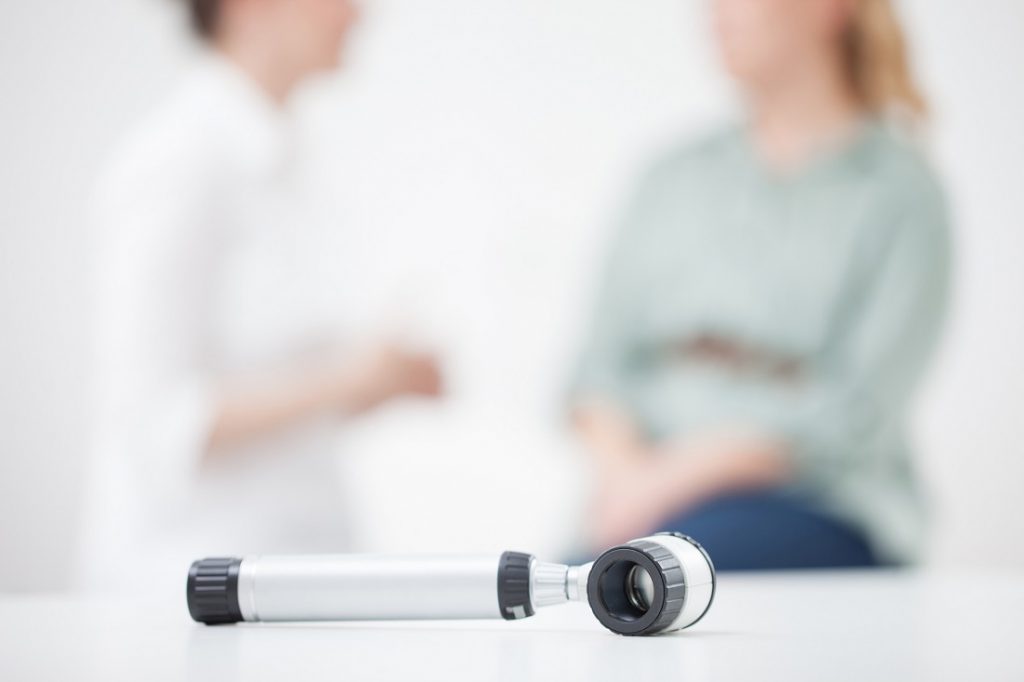Skin lesions don’t come with labels, bells or whistles. Diagnosing skin cancer is way more complicated than you might think. Our two-part article gives you a peek behind the scenes of this little-understood but fascinating area of dermatology. This first part describes how a dermatologist performs a skin exam and determines if all or part of a suspicious spot or lesion should be removed and sent to a lab for a biopsy. It also discusses the highly trained medical specialists who analyze the tissue from your biopsy, and why that is so important. Part two reveals what happens to your biopsy tissue sample, step by step, after your dermatologist ships it off to the lab.
During a skin exam with a dermatologist, you may experience something like this: You’re sitting or lying down in a gown or covered with a cloth. The doctor uncovers one part of your skin at a time, looking closely at any unusual spots, patches, moles or lesions. She’s moving fairly quickly — she’s experienced and knows what she’s looking for. Then she stops and says, “I want to take a closer look at this spot on your shoulder.” She might reach for a small handheld magnifying device called a dermatoscope. “It may be nothing to worry about,” she says, “but I’d like to do a biopsy to be sure.” She numbs the area, then removes all or part of the suspicious lesion, to be sent to a lab for examination. She puts a little ointment on the wound, covers it with a bandage and tells you she will get the results in about a week.
This scenario is common during a full-body skin exam. There’s no reason to panic. Not every biopsy reveals a skin cancer. And even if it does, know that most skin cancers are detected early enough to treat with minimal scarring and a very high chance of a cure. Knowing when and what to biopsy is an important skill set for a dermatologist, but getting an accurate diagnosis is still a complicated process. That’s where a dermatopathologist comes in.
What the heck is a dermatopathologist?
With seven syllables, that’s a mouthful. First, the “pathologist” part: It comes from the Greek pathos (“suffering”), plus logia (“study”). A pathologist is a physician specially trained to study tissue under a microscope to diagnose diseases, determine the stage of a tumor or even help solve crimes through forensics, for example. (You may have an idea of what forensic pathologists do from watching crime shows like CSI.)
The “dermato” part comes from the Greek derma, meaning “skin.” “Dermatopathology is a very specialized niche of pathology, where the only tissue that is being examined is skin,” says Lyn Duncan, MD, director of dermatopathology at Massachusetts General Hospital, and professor of pathology at Harvard Medical School. These specialists are on the lookout for skin cancers as well as other skin conditions, and also diseases of the hair and nails.
To become a dermatopathologist, a physician must have completed a residency in either dermatology or pathology and then have additional training in dermatopathology, explains Michael G. Hitchcock, MBChB (a New Zealand-based medical and surgical degree). He is a dermatopathologist in Winston-Salem, North Carolina, and president of the American Society of Dermatopathology, the largest professional organization devoted to the specialty. “We’re the doctors’ doctor, like the navigator of an aircraft, providing information and feedback to help them make the correct diagnosis.”

Most of the time while a dermatopathologist is looking at a biopsy, says Lyn Duncan, MD, a diagnosis is clear. “That’s where our training and experience come in, although we have to rule out other possibilities.”
Does a skin biopsy always go to a dermatopathologist?
There are between 1,500 and 2,000 dermatopathologists in the U.S., and many of the millions of skin biopsies done by dermatologists or their physician assistants each year go to them,” says Dr. Hitchcock. “It would be rare for a dermatologist to send a biopsy willingly to a general pathologist, although some family practitioners might.”
However, in some cases, an insurance plan or group practice may specify a lab where a biopsy must be sent. “So you’re not always guaranteed that you’ll have a dermatopathologist look at your case,” says Dr. Duncan. This can make it difficult for dermatologists, who often develop a close professional relationship with one dermatopathologist whose opinion they trust, says Dr. Hitchcock. “When the doctors work together regularly, they develop a consistency and clarity of communication that is much more refined and precise, and the nuances are better understood.”
“That is so true,” says Deborah S. Sarnoff, MD, a New York dermatologist and Mohs surgeon who is also president of The Skin Cancer Foundation. She explains that 15 or 20 years ago, managed care companies had contracts with certain labs, and they were starting to dictate the lab to which biopsies had to be sent. “Who was looking at that tissue? It wasn’t necessarily a board-certified dermatopathologist,” she says. Several professional organizations, including the American College of Mohs Surgery and the American Academy of Dermatology, banded together to advocate for the right to use a dermatopathologist. “It was a major win,” she says. But it’s still not always a given.
What can patients do?
Some good advice from the experts:
- Dr. Hitchcock says it’s worth asking whoever is doing your biopsy whether or not it will be seen by a dermatopathologist. “The biopsy specimens are super easy to transport, so even if there is no dermatopathologist in your area, that’s not a hurdle to getting it to one.”
- “You should also make sure your insurance covers you for the lab where the doctor is going to send your biopsy,” Dr. Sarnoff advises. You can call the 800-number on your insurance card, or ask your doctor’s insurance manager to help.
- Dr. Duncan adds: “Also, if the diagnosis comes back and the dermatologist says, ‘This is a little bit surprising; it’s not what I expected,’ ask the dermatologist to discuss it with the dermatopathologist or ask for a second opinion with another review of the biopsy.”





